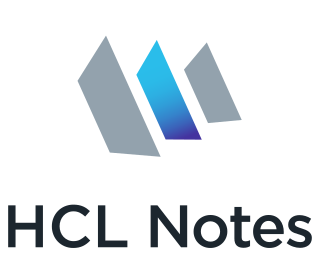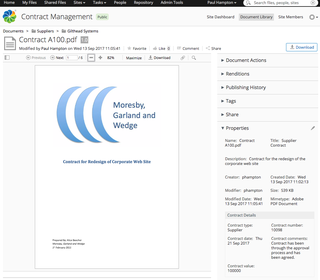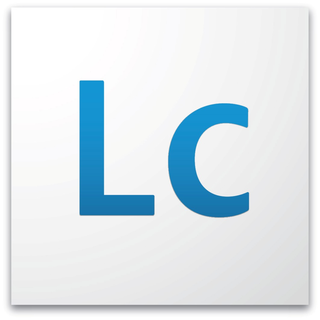
HCL Notes is a proprietary collaborative software platform for Unix, Windows, Linux and macOS, sold by HCLTech. The client application is called Notes while the server component is branded HCL Domino.

Db2 is a family of data management products, including database servers, developed by IBM. It initially supported the relational model, but was extended to support object–relational features and non-relational structures like JSON and XML. The brand name was originally styled as DB2 until 2017, when it changed to its present form.

OpenText Corporation is a Canadian company that develops and sells enterprise information management (EIM) software.
Enterprise content management (ECM) extends the concept of content management by adding a timeline for each content item and, possibly, enforcing processes for its creation, approval, and distribution. Systems using ECM generally provide a secure repository for managed items, analog or digital. They also include one methods for importing content to bring manage new items, and several presentation methods to make items available for use. Although ECM content may be protected by digital rights management (DRM), it is not required. ECM is distinguished from general content management by its cognizance of the processes and procedures of the enterprise for which it is created.
DocuShare is a content management system developed by Xerox Corporation. DocuShare makes use of open standards and allows for managing content, integrating it with other business systems, and developing customized and packaged software applications.

Alfresco Software is a collection of information management software products for Microsoft Windows and Unix-like operating systems developed by Alfresco Software Inc. using Java technology. The software, branded as a Digital Business Platform is principally a proprietary & a commercially licensed open source platform, supports open standards, and provides enterprise scale. There are also open source Community Editions available licensed under LGPLv3.

Uniface is a low-code development and deployment platform for enterprise applications that can run in a large range of runtime environments, including mobile, mainframe, web, Service-oriented architecture (SOA), Windows, Java EE, and .NET. Uniface is used to create mission-critical applications.
Enterprise content integration (ECI) is a marketing buzzword for middleware software technology. It is often used within large organizations, that connect various types of computer systems that manage documents and digital content. ECI systems often work in tandem with other technologies such as enterprise content management, document management, groupware, and records management. It takes a decentralized approach in order to manage content from various resources. ECI implementations exist on a tier above the organization's existing software and provide wide-ranging search, indexing, and access functions.

Adobe LiveCycle Enterprise Suite (ES4) is a service-oriented architecture Java EE server software product from Adobe Systems used to build applications that automate a broad range of business processes for enterprises and government agencies. LiveCycle ES4 is an enterprise document and form platform that helps you capture and process information, deliver personalized communications, and protect and track sensitive information. It is used for purposes such as account opening, services, and benefits enrollment, correspondence management, requests for proposal processes, and other manual-based workflows. LiveCycle ES4 incorporates new features with a particular focus on mobile devices. LiveCycle applications also function in both online and offline environments. These capabilities are enabled through the use of Adobe Reader, HTML/PhoneGap, and Flash Player clients to reach desktop computers and mobile devices.
Cyn.in is an open-source enterprise collaborative software built on top of Plone a content management system written in the Python programming language which is a layer above Zope. Cyn.in is developed by Cynapse a company founded by Apurva Roy Choudhury and Dhiraj Gupta which is based in India. Cyn.in enables its users to store, retrieve and organize files and rich content in a collaborative, multiuser environment.

Dell EMC Isilon is a scale out network-attached storage platform offered by Dell EMC for high-volume storage, backup and archiving of unstructured data. It provides a cluster-based storage array based on industry standard hardware, and is scalable to 50 petabytes in a single filesystem using its FreeBSD-derived OneFS file system.

SharePoint is a web-based collaborative platform that integrates natively with Microsoft 365. Launched in 2001, SharePoint is primarily sold as a document management and storage system, although it is also used for sharing information through an intranet, implementing internal applications, and for implementing business processes.
Microsoft SQL Server is a proprietary relational database management system developed by Microsoft. As a database server, it is a software product with the primary function of storing and retrieving data as requested by other software applications—which may run either on the same computer or on another computer across a network. Microsoft markets at least a dozen different editions of Microsoft SQL Server, aimed at different audiences and for workloads ranging from small single-machine applications to large Internet-facing applications with many concurrent users.

FileNet, a company acquired by IBM, developed software to help enterprises manage their content and business processes. FileNet P8, their flagship offering, is a framework for developing custom enterprise systems, but it can be used as-is.
eRoom is an on-line project collaboration, or collaborative software product from Opentext Corporation. Originally developed by eRoom Technology Inc., of Cambridge, Massachusetts, product features include e-mail management, calendaring, instant messaging, project plans, databases, and document management.
Content Management Interoperability Services (CMIS) is an open standard that allows different content management systems to inter-operate over the Internet. Specifically, CMIS defines an abstraction layer for controlling diverse document management systems and repositories using web protocols.
HP Information Management Software is a software from the HP Software Division, used to organize, protect, retrieve, acquire, manage, and maintain information. The HP Software Division also offers information analytics software. The amount of data that companies have to deal with has grown tremendously over the past decade, making the management of this information more difficult. The University of California at Berkeley claims the amount of information produced globally increases by 30 percent annually. An April 2010 Information Management article cited a survey in which nearly 90 percent of businesses blame poor performance on data growth. The survey concluded that for many businesses their applications and databases are growing by 50 percent or more annually, making it difficult to manage the rapid expansion of information.

SAP HANA is an in-memory, column-oriented, relational database management system developed and marketed by SAP SE. Its primary function as the software running a database server is to store and retrieve data as requested by the applications. In addition, it performs advanced analytics and includes extract, transform, load (ETL) capabilities as well as an application server.








